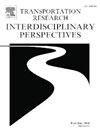2017-2019年美国国家步行指数与交通相关行人死亡之间的关系
IF 3.9
Q2 TRANSPORTATION
Transportation Research Interdisciplinary Perspectives
Pub Date : 2025-03-28
DOI:10.1016/j.trip.2025.101404
引用次数: 0
摘要
尽管增加了对旨在促进和保护步行的基础设施的投资,但在2010年至2022年期间,美国交通相关行人死亡率增长了87.8%。本研究旨在探讨鼓励步行的建筑环境特征的综合措施如何影响整体和跨城市化水平的行人风险。方法利用美国环境保护署国家步行指数(NWI)和美国国家公路交通安全管理局2017-2019年死亡人数分析报告系统的数据,采用多级负二项回归模型,研究了步行得分(范围1-20)、得分越高,表明存在建筑环境特征(增加人们步行出行的可能性)和人口普查街区组水平常住人口的行人死亡率。结果在校正后的块组水平模型中,NWI评分每高5分,行人死亡率增加29% (IRR: 1.29, 95% CI: 1.27 - 1.32)。按城市化程度分层的模型显示,城市街区组的NWI相关性较强(IRR: 1.34, 95% CI: 1.31 - 1.37),而孤立的农村城镇街区组的NWI相关性呈负相关(IRR: 0.56, 95% CI: 0.43 - 0.72)。结论这些结果表明,促进步行行为的建筑环境干预可能受益于额外的行人安全改善。目前全国范围内的步行性数据并不能准确地描述行人的安全性;然而,这些数据可以用来确定行人安全干预的优先位置。本文章由计算机程序翻译,如有差异,请以英文原文为准。
Associations between National walkability Index and Traffic-Related pedestrian Deaths, United States, 2017–2019
Background
Despite increased investment in infrastructure designed to promote and protect walking, rates of traffic related pedestrian deaths have increased by 87.8% between 2010 and 2022 in the United States. This study aims to investigate how comprehensive measures of built environmental features that encourage walking impact pedestrian risks overall and across levels of urbanicity.
Methods
Using data from the Environmental Protection Agency’s National Walkability Index (NWI) and National Highway Traffic Safety Administration 2017–2019 Fatality Analysis Reporting System, multilevel negative binomial regression models were used to examine the relationship between walkability score (range 1–20, with higher scores indicating the presence of built environment characteristics that increase the likelihood that people will walk for transportation) and pedestrian death rates by resident population at the census block group level.
Results
In adjusted, block group level models, a 5-point higher NWI score was associated with a 29% increase in the rate of pedestrian deaths (IRR: 1.29, 95% CI: 1.27 – 1.32). Models stratified by urbanicity showed a stronger association of NWI in urban block groups (IRR: 1.34, 95% CI: 1.31 – 1.37) and an inverse association of NWI in isolated rural town block groups (IRR: 0.56, 95% CI: 0.43 – 0.72).
Conclusion
These results suggest that built environment interventions which promote walking behavior may benefit from additional pedestrian safety improvements. Current nationwide walkability data do not accurately characterize pedestrian safety; however, these data may be used to identify places to be prioritized for pedestrian safety interventions.
求助全文
通过发布文献求助,成功后即可免费获取论文全文。
去求助
来源期刊

Transportation Research Interdisciplinary Perspectives
Engineering-Automotive Engineering
CiteScore
12.90
自引率
0.00%
发文量
185
审稿时长
22 weeks
 求助内容:
求助内容: 应助结果提醒方式:
应助结果提醒方式:


